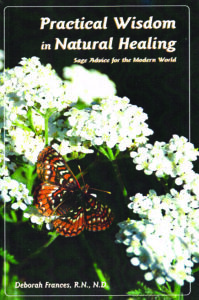Chris Chlebowski, DC, ND
Dr Frances started her career as a registered nurse, familiarizing herself – but soon becoming disenchanted with – the conventional medical model. She began the study of homeopathy in her late 20s before enrolling in naturopathic school. Despite her initial indoctrination into allopathic medicine, she embraces the basic tenets of naturopathic medicine wholeheartedly and with great success.By the time I went to naturopathic school, the tide was already turning. The old guard professors who prescribed herbs, homeopathy, and hydrotherapy, and felt confident using these modalities for serious conditions, were being booted out to be replaced by younger, more inexperienced doctors. These new graduates relied heavily on pharmaceutical medications and tended to make frequent referrals to allopathic physicians when unsure what to do. A few of the old school docs still remained to fight the good fight. Folks like Dr Durr Elmore, Dr Judy Peabody, and Dr Deborah Frances were among the last bastion of naturopathic physicians who could pull a patient out of a tough spot with a solid homeopathic prescription or just the right herbal formula. Fortunately, Dr Deborah Frances took the time to record much of what she has gleaned from years of experience. The resulting book – Practical Wisdom in Natural Healing – is loaded with practical clinical tips that are easily applied and have proven efficacious over and over in her family practice.
The Book
A review of the basic precepts of naturopathic medicine in the first 2 chapters both inspires and informs, educating those who are not familiar with these principles while offering a welcome refresher for those who are. Case stories interspersed throughout the section blend with a gentle tapestry of traditional Native American teachings to bring a philosophy of healing, deeply rooted in the immutable laws of nature, fully alive and accessible to all.
The bulk of the book is devoted to outlining naturopathic protocols for specific conditions common to everyday family practice. The chapter devoted to musculoskeletal conditions includes an easy-to-prescribe homeopathic remedy guide to relieve radicular pain. Further discussion details an aggressive dosing of anti-spasmodic herbs, which essentially eliminates the need for pharmaceutical muscle relaxers. I especially appreciate her willingness to discuss indications and safe uses of the herb Atropa belladonna, an amazing ally in alleviating more severe muscle spasm when administered in small, frequent doses.
In sequential chapters, Dr Frances depicts herbal and homeopathic treatments appropriate to a wide variety of conditions. Each chapter is devoted to a specific organ or organ system, and all are chock full of clinical tips for a multitude of acute and chronic conditions common to family practice.
Respiratory & Cardiovascular Health
The chapter on respiratory ailments includes a thorough discussion of pertussis, as well as protocols for bronchitis, pleurisy, COPD, asthma, hay fever, and sinusitis, and a homeopathic tip for successfully shrinking nasal polyps. Another chapter devoted to the cardiovascular herb, hawthorn, elucidates her original use of this plant for bringing quick relief to acute bronchospasm in patients suffering with asthma or COPD, allowing for rapid, easy weaning from pharmaceutical inhalers. This chapter also describes the more conventional use of hawthorn for angina, functional heart palpitations, and impending cerebrovascular events, as well as her use of the herb in treating grief or depression. The following chapter on hypertension utilizes the same herb to build a foundation for the success of non-pharmaceutical treatment of hypertension.
Reproductive & Digestive Health
In the section devoted to women’s health, Dr Frances again draws on the teachings of her Native American ancestry, this time to emphasize the importance of reclaiming the sacred aspects of menarche, menses, and menopause before outlining naturopathic protocols for everything from bacterial vaginosis to pelvic inflammatory disease and menorrhagia. In her section on menopause, the need for hormone replacement is obviated as she shares successful protocols for relieving hot flashes, vaginal dryness, and a host of other symptoms. A chapter delineating herbal and homeopathic tips for the treatment of erectile dysfunction begins with references to the sacred aspects of the masculine and the importance of addressing the emotional and spiritual wounds patriarchy has inflicted onto men – a perspective refreshing to hear, especially from a woman writer.
Her discussion of digestive function includes naturopathic therapies for successful treatment of acute and chronic cholecystitis and appendicitis, as well as a section on the health of the liver.
Homeopathy
Although guidelines are given for prescribing common constitutional remedies, most of the homeopathic tips are geared for acute prescribing, where she outlines obvious indications to easily differentiate the few most likely remedies she lists, thus making successful prescribing easily accessible for the non-homeopath. In the chapter on first aid, for example, Dr Frances portrays the use of homeopathic Eupatorium perfoliatum for the treatment of acute bone pain due to fracture, then shares a case in which a patient manages quite well without any need for allopathic pain medication. In the same chapter, a differential discussion of 5 or 6 remedies for the treatment of infected wounds is followed by a case where a puncture wound from a cat bite was treated exclusively with homeopathy, herbs, and poultices.
Herbal Medicine
An early chapter on adrenal adaptogens emphasizes the importance of utilizing this group of herbs in generous doses, and sets a foundation for treating many of the conditions covered later in the book. Another chapter, on nervines, contains a full discussion of several respiratory herbs and offers a bevy of tools for enhancing one’s skills in botanical prescribing. Herbal enthusiasts will appreciate Dr Frances’ ability to bring the plants alive, as she offers specific indications that enable practitioners to select herbs based on the emotional and spiritual makeup of the patient, as well as on physical symptoms.
Another whole chapter is devoted to the art of herbal formulation. I have fond memories of Dr Frances standing at the chalkboard in the student clinic, hashing out an individualized formula of herbs while wide-eyed students, eager to participate, soaked up her knowledge. Unlike so many practitioners, she never allowed us to simply rattle off any 10 herbs and pour them into a bottle. On the contrary, Dr Frances always made certain we chose each herb as if we were inviting guests to a dinner party, making sure that all complemented one another and that none would offend. Her chapter on formulations illustrates these teachings as she helps the reader integrate the ability to choose herbs that synergize with one another and address the patient as a whole.
Are We in Danger of Losing Our Roots?
The ever-expanding formulary being made available to naturopathic physicians in many states is a double-edged sword. Naturopathic schools, once rising valiantly to meet the extraordinary challenge of teaching medical assessment skills, differential diagnosis, and the modalities and philosophy of naturopathic medicine in 4 years, now find they must add the burden of teaching proficiency in prescribing allopathic drugs. Supervising doctors working in student clinics are being encouraged to prescribe more pharmaceuticals, resulting in new graduates who enter into practice with less than a firm clinical foundation in traditional naturopathic therapies. Who can blame them for reaching more and more for antibiotics, steroids, meds for hypertension, hormones, and a whole host of other pharmaceuticals for conditions their predecessors once treated easily and successfully using the traditional tools of nature? Like osteopathic medicine of the past, naturopathy, meant to provide a viable alternative to allopathic medicine, is in danger of losing its roots.
During the many times I had the opportunity to work with Dr Frances in clinic, I never once saw her reach for a prescription pad. This was not because she was dogmatic, but because she always had a better tool – one that was at least, if not more, effective than any pharmaceutical and without all the potential side effects. Acute pancreatitis, thyroid storms, streptococcal pharyngitis, and a whole host of other conditions fell away with her deft, traditional prescribing.
Summary
Dr. Frances writes in a language that is accessible to the lay reader, and is invaluable to the physician. Case histories, scattered liberally throughout the book, bring the medicine alive, dramatically illustrating the healing powers of nature-based therapies. Since acquiring the book, I find myself reaching for it often during patient consultations. The table of contents and indexes are arranged for quick and easy reference in even the busiest clinical practice.
This book is as absolute must for any serious prescriber or layperson who wants to help themselves, their families, and their patients reunite with the healing power inherent in nature and avoid the pitfalls of invasive, toxic, and suppressive allopathic treatments whenever possible. Practical Wisdom in Natural Healing offers a refreshing reminder that natural therapies really do work, and it shows us how to apply them, easily, and effectively.
- Title: Practical Wisdom in Natural Healing: Sage Advice for Modern Times
- Author: Deborah Frances, ND
- Publisher: Self-Published
- Available through: drdeborahfrances@wordpress.com
- Pages: 332
- Style: Soft Cover
- Copyright: 2014
- MSRP: $24.95
 Chris Chlebowski, DC, ND, practices full-time in Ashland, Oregon, where he focuses on chronic infections, autoimmunity, and neurological disorders that he treats in the old, classic style of naturopathy.
Chris Chlebowski, DC, ND, practices full-time in Ashland, Oregon, where he focuses on chronic infections, autoimmunity, and neurological disorders that he treats in the old, classic style of naturopathy.

